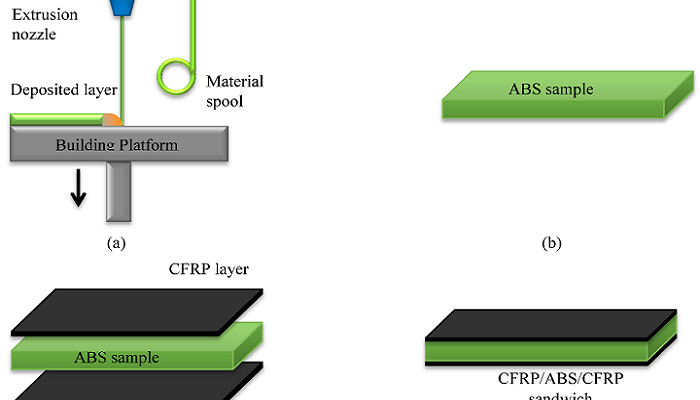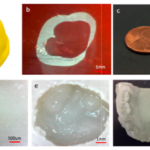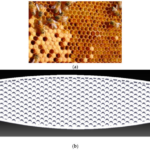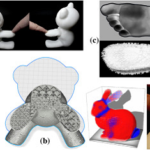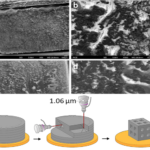
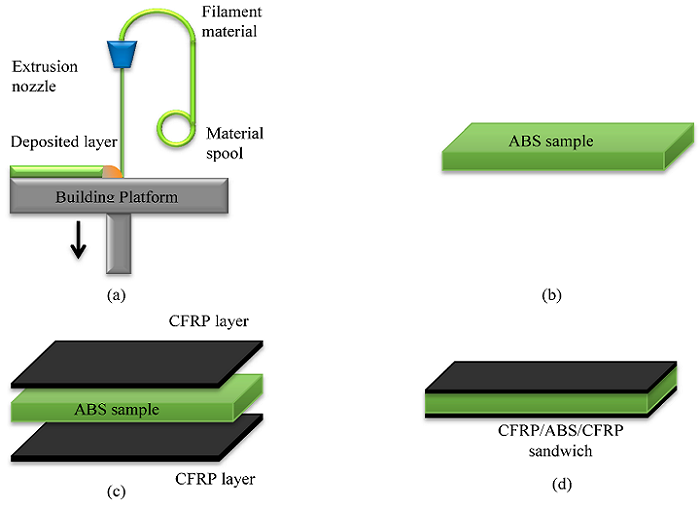
A collaborative team of researchers from Kingston University, the University of Liverpool, and Khalifa University of Science and Technology recently published a paper, titled “Additive Manufactured Sandwich Composite/ABS Parts for Unmanned Aerial Vehicle Applications,” that looks into using sandwich-structured composites with core material fabricated by FDM 3D printing, laminated with a thin, carbon fiber-reinforced polymer (CFRP) skin, in order to improve the strength and mechanical properties of 3D printed polymeric parts for use in high performance applications, such as drones, which are also called Unmanned Aerial Vehicles (UAVs).
The abstract reads, “Fused deposition modelling (FDM) is one of most popular 3D printing techniques of thermoplastic polymers. Nonetheless, the poor mechanical strength of FDM parts restricts the use of this technology in functional parts of many applications such as unmanned aerial vehicles (UAVs) where lightweight, high strength, and stiffness are required. In the present paper, the fabrication process of low-density acrylonitrile butadiene styrenecarbon (ABS) with carbon fibre reinforced polymer (CFRP) sandwich layers for UAV structure is proposed to improve the poor mechanical strength and elastic modulus of printed ABS. The composite sandwich structures retains FDM advantages for rapid making of complex geometries, while only requires simple post-processing steps to improve the mechanical properties. Artificial neural network (ANN) was used to investigate the influence of the core density and number of CFRP layers on the mechanical properties. The results showed an improvement of specific strength and elastic modulus with increasing the number of CFRP. The specific strength of the samples improved from 20 to 145 KN·m/kg while the Young’s modulus increased from 0.63 to 10.1 GPa when laminating the samples with CFRP layers. On the other hand, the core density had no significant effect on both specific strength and elastic modulus. A case study was undertaken by applying the CFRP/ABS/CFRP sandwich structure using the proposed method to manufacture improved dual-tilting clamps of a quadcopter UAV.”
Many engineers have worked to improve the performance of UAVs by making them more lightweight and with more endurance, which can be achieved by using materials with high strength, impact properties, and stiffness. CFRP composites are lightweight but strong materials that can be used in applications such as robotic arms, structural, automotive, and aerospace due to their excellent properties, such as corrosion resistance and fatigue.
“Sandwich-structured composite is a unique class of materials that is manufactured by adding two thin skin layers to a thick and lightweight core. They offer a superior specific strength and stiffness when compared to monolithic composites. The core material is commonly cheaper and has lower strength and density when compared to the skin layers,” the researchers explained.

3D printing methods that can make very robust parts, such as SLM and EBM, can be quite expensive, but common FDM 3D printing is unable to make its thermoplastic parts strong enough for high-performance applications. Many have tried to increase the strength of 3D printed plastic parts, with such ideas as an ultrasonic strengthening technique and using high strength resin to fill the voids, but the researchers believe that presently, “the use of sandwich-structured composite to improve the mechanical properties of 3D printed plastic parts is lacking.”
“The experiments performed in this paper aimed to identify whether the use of CFRP/ABS/CFRP sandwich composites can have improved mechanical properties when compared to the monolithic 3D printed parts and what is the optimum number of CFRP layers to maximize the specific strength and the Young’s modulus,” the researchers wrote.
The team used UP BOX 3D printers to fabricate samples for testing and experimentation, such as applying tensile measurements to the samples with different numbers of CFRP layers and infill densities. In addition, the research also focused on properties prediction, as well as the relationship between process parameters and the properties of the novel ABS/CFRP/ABS sandwich structure, using both neural network analysis and surface response.
“It was found that the ultimate strength and stiffness were significantly improved with applying CFRP sandwich layers. Under tensile loading, the ABS/CFRP/ABS sandwich structure exhibit behaviour brittle, while it was ductile for monolithic ABS samples. The ultimate strength improved about nine times and the Young’s modulus increased about 16 times as compared to the as printed samples,” the researchers concluded. “A surface response model was established to predict the material properties from the process parameters. The adequacy of the surface response model was verified. In addition, a nonlinear predictor based on artificial neural networks is developed to predict the elastic modulus and specific strength of composite material. The predicated results of the developed artificial neural networks have an excellent accuracy when compared to experimental data.”
Co-authors of the paper are Athanasios Galatas, Hany Hassanin, Yahya Zweiri, and Lakmal Seneviratne.
Discuss this research and other 3D printing topics at 3DPrintBoard.com or share your thoughts below.
When it comes to 3D real estate visualization in the USA, our service provides the perfect solution for bringing property listings to life. Through our platform, you can easily access cutting-edge 3D renderings that showcase your real estate projects in a way that attracts potential buyers and investors. Whether it's residential, commercial, or mixed-use properties, our team of experts uses advanced technology to create immersive visualizations that highlight the best features of your property, making it easier for clients to imagine the space as their own.
Through our website, you can quickly get high-quality 3D real estate visualizations that are tailored to your specific needs. With our help, you'll stand out in the competitive real estate market by offering potential buyers a realistic, interactive view of your property. Our efficient process ensures a fast turnaround time, while our attention to detail guarantees that every aspect of the property is represented accurately, giving you a powerful marketing tool to promote your real estate listings.


